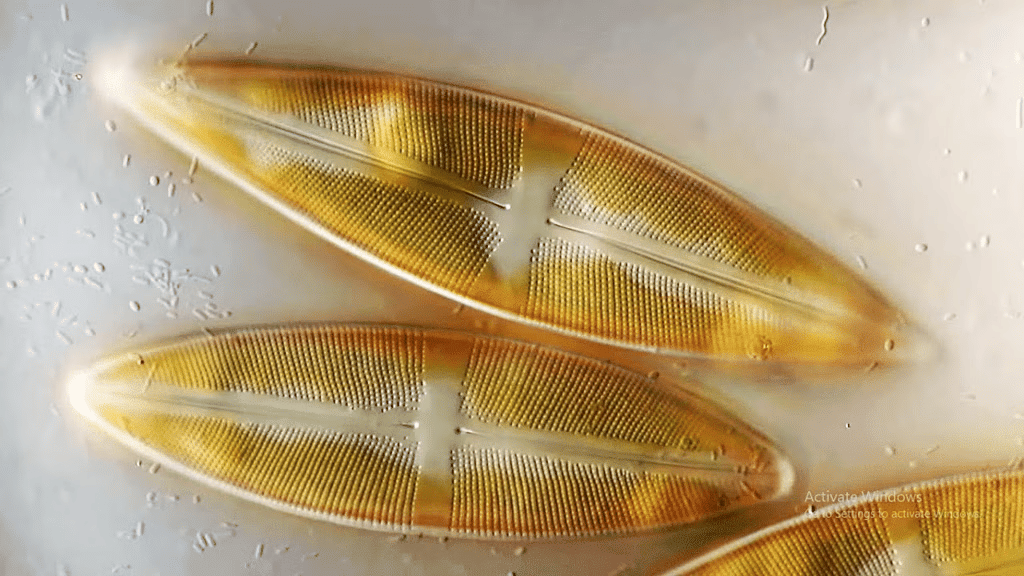Kingdom Protista: Chrysophytes and Dinoflagellates | Biology Class 11 - NEET PDF Download
Protista is a kingdom that includes all single-celled eukaryotes. However, the boundaries of this kingdom are not well defined, as some organisms may be considered protists by some biologists but classified as plants, animals, or fungi by others.
Protists are primarily aquatic organisms and form a link between other kingdoms such as plants, animals, and fungi. Protists are eukaryotes, which means their cells have a well-defined nucleus and other membrane-bound organelles. Some protists also have flagella or cilia for movement. Protists reproduce both asexually and sexually, involving processes such as cell fusion and zygote formation.
 Golden algae
Golden algae
Chrysophytes
- This group consists of diatoms and golden algae (also known as desmids).
- They can be found in both freshwater and marine environments.
- Chrysophytes are microscopic and float passively in water currents, making them a part of the plankton community.
- Most of these organisms are photosynthetic, meaning they produce their food using sunlight.
- In diatoms, the cell walls are made up of two thin overlapping shells that fit together like a soap box.
- These walls are embedded with silica, which makes them indestructible.
- Over time, diatoms have left behind large deposits of their cell walls in their habitats, and this accumulation over billions of years is known as diatomaceous earth.
 Diatoms
Diatoms - Diatomaceous earth is gritty and is used in various applications such as polishing and filtration of oils and syrups.
- Diatoms play a crucial role as the chief producers in the oceans, forming the base of the marine food web.
Dinoflagellates
- These organisms are primarily found in marine environments and are capable of photosynthesis.
- Their appearance can vary in color, including yellow, green, brown, blue, or red, depending on the predominant pigments in their cells.
- The cell wall of dinoflagellates is covered with rigid cellulose plates.
- Most dinoflagellates have two flagella: one positioned longitudinally and the other transversely, located in a furrow between the wall plates.
- Occasionally, red dinoflagellates, such as Gonyaulax, reproduce rapidly, causing the ocean to appear red, a phenomenon known as red tides.
 Dinoflagellate
Dinoflagellate
- The toxins released during such blooms can be harmful and even lethal to other marine animals, including fish.
FAQs (Frequently Asked Questions)
Q. What are Protists?
Protists are a diverse group of organisms that can be either single-celled or multicellular, possessing a nucleus and specialized cellular machinery called cell organelles. They can exhibit various life processes and can be autotrophic (such as algae), heterotrophic (like Amoeba), or even parasitic (such as Trypanosoma protozoa).
Q. How are Protists classified?
Protists are classified into 5 subdivisions based on their characteristic features, which are:
- Chrysophytes
- Dinoflagellates
- Euglenoids
- Slime molds
- Protozoans
Q. Provide some examples of Protists.
Examples of Protists include Amoeba, Paramecium, Euglena, Plasmodium, and others.
Q. Are all Protists unicellular?
No, not all Protists are unicellular. Some Protists, such as molds and algae, are multicellular, composed of more than one cell. However, organisms like Amoeba, Paramecium, and Euglena are unicellular and belong to the kingdom Protista.
Q. Outline the characteristics of Kingdom Protista.
- All protists are eukaryotic, possessing a membrane-enclosed nucleus and other cell organelles.
- Most protists are aquatic, while some can be found in moist and damp environments.
- Most protists are unicellular, although some, like giant kelp, are multicellular.
- Protists can be autotrophic or heterotrophic in nature, and parasitism and symbiosis can also be observed in some.
|
180 videos|367 docs|148 tests
|
























